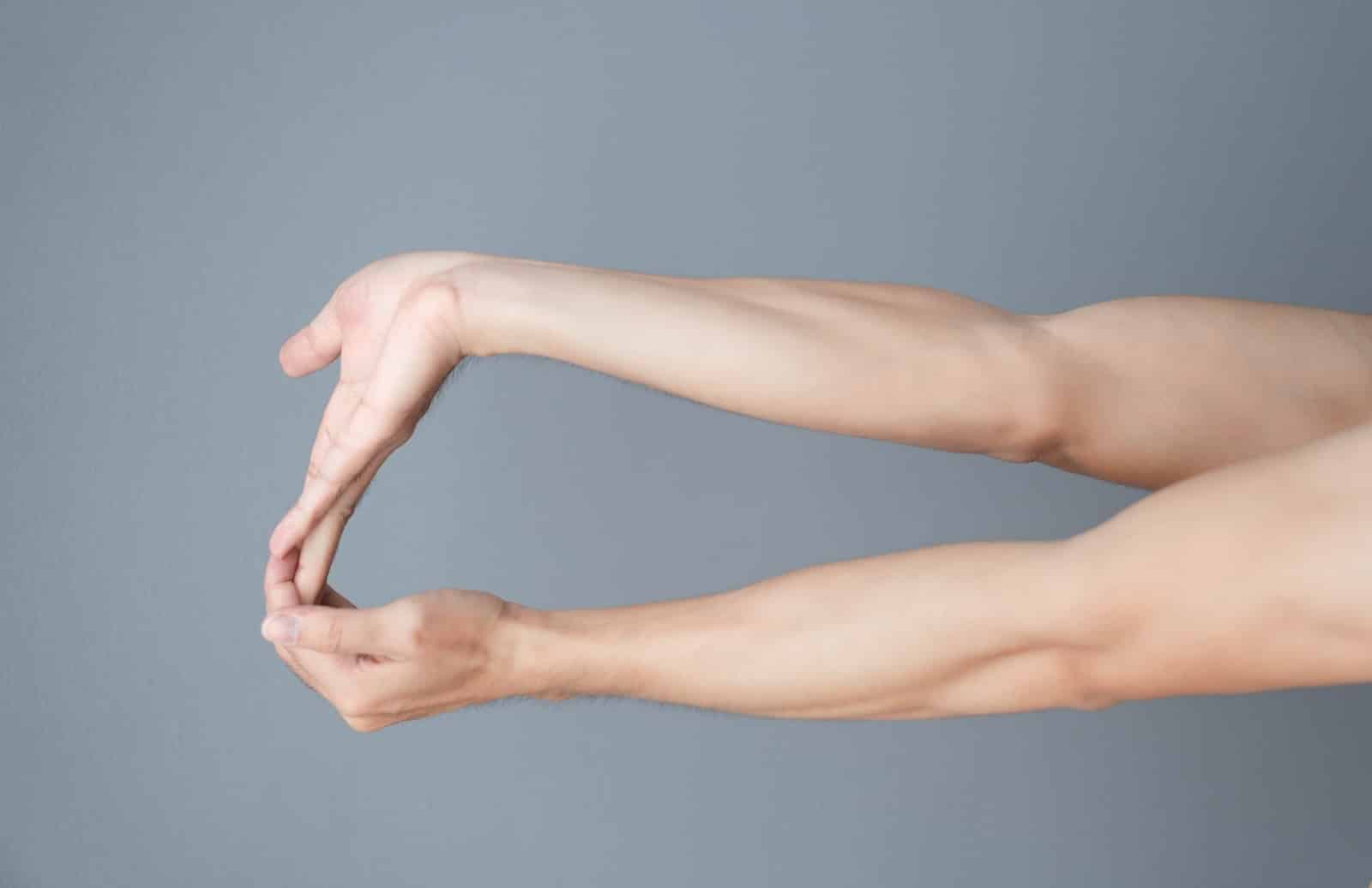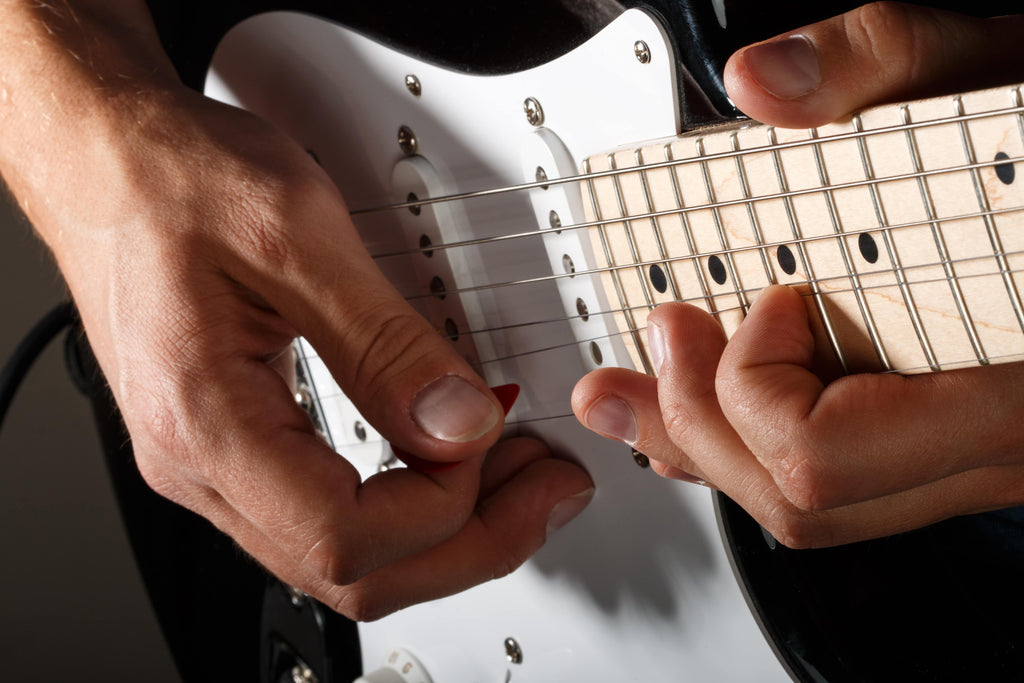
10 Proven Strategies to Relieve Hand and Wrist Pain for Guitarists
Disclaimer: This article is not intended to be a substitute for professional medical advice, diagnosis, or treatment. Always seek the advice of your doctor, hand therapist, occupational therapist, or another qualified health provider with any questions you may have regarding a medical condition.
Most beginners new to playing guitar will experience finger and wrist pain, but what about experienced guitar players who develop repetitive strain injuries like Carpal Tunnel Syndrome?
If your wrist hurts, you're not alone! A guitar player who plays for long periods is not only likely to develop wrist pain and hand injuries, but they may also develop bad posture, and experience tendonitis in their arm; tension in their shoulder; and tight muscles in their back.

Here are 10 things that guitar playing musicians can do to address these common issues and avoid wrist pain.
(1) Perform a guitar "sitting/standing self-assessment" to prevent incorrect posture while you play
Excellent guitar posture is essential for avoiding hand and wrist pain when playing the instrument. It's important to start off with good posture to ensure your form doesn't worsen throughout your playing session. To maintain the best posture while playing guitar for long periods:
- Sit or stand upright with your feet firmly on the floor, back straight, and shoulders relaxed.
- To ensure maximum comfort while playing, you should hold the guitar against your body with the strap adjusted to a height that is comfortable for you.
- Make sure to keep your elbows close and wrists in a neutral position - not too high or low. For right-handed players, the left hand should be situated on the guitar's neck with your thumb behind it and fingers curved to press down the strings.

A great guitar teacher should be able to confirm that your body posture is correct and help you adjust as needed to prevent wrist pain.
(2) Make sure your guitar is set up correctly
A properly set-up guitar can help reduce the amount of strain on your wrist. Before you start playing, check for a low action (the distance between the strings and fretboard) by pressing down on each string at the 12th fret - there should be very little gap between them. The nut and bridge should also be properly adjusted to make sure that the strings are not too high or low. Additionally, make sure to use lighter gauge strings as they require less force to fret, leading to a reduction in hand and wrist fatigue.
(3) Warm up before playing guitar
As a guitar player, it's important to warm up properly by doing some light stretches and exercises before playing to loosen the muscles in your hands/wrist. There are several stretches that can be used as a warm-up for guitar players to prepare them for playing. Be sure to do these before you feel pain. Some examples include:
Finger stretches
Spread your fingers as wide as you can, then close them into a fist. Repeat this several times before you play.
Wrist stretches
Hold your arm out straight in front of you, then rotate your wrist clockwise and counterclockwise. Repeat this several times with both hands.
Forearm stretches
Hold your arm out straight in front of you with your hand open, then rotate your hand so that your fingers point towards the ground. Use your other hand to gently push your fingers towards your wrist, stretching the muscles. Repeat this several times with both hands.

Improving your finger dexterity can help make fretting notes and playing barre chords easier and faster while reducing the strain on your hands.
There are many exercises you can do to help improve wrist dexterity, such as scales or finger-picking patterns. These will not only help build strength in your hands but also improve your ability to play more complex pieces of music.
Other finger stretches for guitar
Other video resources where guitar players can find helpful warm-up stretches and wrist strengthening exercises include:
- YouTube: https://www.youtube.com/watch?v=7_0aVxFxBa0
- YouTube: https://www.youtube.com/watch?v=t-HBp7TQC38
- YouTube: https://youtu.be/Au2wPpcU6Zs
- If you are working with a professional guitar teacher, they may be able to guide you in a warm-up/strengthening routine for preventing wrist injuries, pain in your forearm muscles, shoulder pain, and tendonitis.
(4) Use good technique when fretting
The way you press down on the strings with your fretting hand can have an impact on how much stress is placed on your hands while you play. When fretting, ensure that each finger is curved slightly to press down the strings with minimal effort and in a way that won't cause any tension or strain on the muscles of the hands.
(5) Try alternate tunings to increase wrist comfort
Many guitarists try alternate tunings such as open G or dropped D can reduce the amount of tension and stress on their hands, wrists, and forearms as less pressure is required to fret a note. This can be especially helpful for those suffering from hand pain or arthritis.
(6) Use a pick grip that is comfortable for you while you play
The way you hold the pick can have an impact on how much strain is put on your hand and wrist muscles. For example, if you hold the pick too tight, it can put additional strain on your wrist, leading to severe guitar wrist pain and Carpal Tunnel Syndrome. Start learning/experiment with different grips to find a pick grip that is comfortable for your body.

(7) Self-massage using massage balls or other massage therapy devices
Self-massage is a great way to alleviate hand and wrist pain after playing the guitar. Products like Rawlogy's Micro Massage Balls for hands and fingers, Rawlogy's forearm and shoulder Mini Massage Balls, foam rollers, and other massage therapy devices can help alleviate guitar wrist pain, as well as other parts of the body
Massaging the areas used in playing the guitar can help to increase blood flow and flexibility, which can help to prevent injury and improve overall performance.
Some specific massage techniques that may decrease pain for guitar players include:
- Hand and finger massage: Use your hand or a micro massage ball to gently massage the muscles and tendons in your hands and fingers. This can help to relax the muscles, which can help to soothe guitar tendonitis, pain, and cramping.
- Wrist and forearm massage: Gently massage the muscles and tendons using your hand, a 2" massage ball, or a micro massage ball. Apply more pressure slowly. This can help to increase flexibility, prevent wrist pain and reduce the risk of repetitive strain injuries.

It is important to remember to massage gradually and never to push beyond your own limits. You don't want your wrist hurt worse! And also, if you are experiencing severe guitar wrist pain or discomfort, it's always best to consult a physical therapist or other medical professionals.
(8) Take breaks during guitar practice
Taking regular breaks during long practice sessions will help alleviate hand and wrist pain. When stopped playing for a few minutes, perform some light stretches while sitting or standing to relax your muscles as well as give the rest of your body a chance to recover from the strain.
(9) Use an ergonomic guitar strap
Guitar straps can be an essential tool in supporting proper posture while playing guitar. An ergonomic design will distribute the weight of the guitar evenly across your shoulder and back muscles to reduce fatigue and decrease guitar wrist pain. Additionally, look for straps with adjustable lengths that are comfortable when playing guitar while standing.
(10) Consult with a medical professional
If you are experiencing chronic wrist pain, shooting pain, tension, tendonitis, or discomfort while playing the guitar, it is best to consult with a medical doctor or other professional for advice on how to manage the condition and symptoms you may be having.

They may be able to provide treatments or exercises designed to reduce the pain and improve your ability to play.
Conclusion
By following these tips, you can help reduce hand and wrist pain while playing guitar. Remember, proper technique and taking breaks when necessary are key factors in reducing pain from playing the guitar. With practice and dedication to warm up stretches, exercises, posture adjustments, massage, and technique, you can find the perfect balance between playing time and rest to ensure your hands stay healthy.

